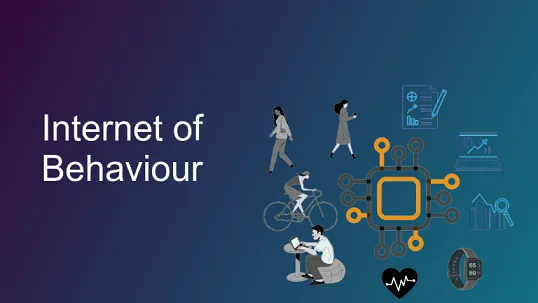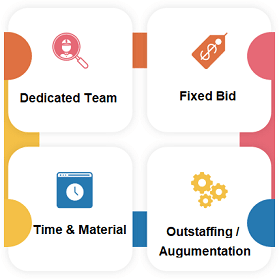IoB then refers to a process by which user-controlled data is analysed through a behavioural psychology perspective. The results of that analysis, inform new approaches to designing a user experience (UX), search experience optimisation (SXO), and how to market the end products and services offered by companies. Consequently, for a company to conduct IoB is technically simple, but psychologically complex. It requires statistical studies to be conducted that map everyday habits and behaviours without fully disclosing consumer privacy for ethical and legal reasons.
In addition, IoB combines existing technologies that focus on the individual directly such as facial recognition, location tracking and Big Data.
Internet of Behaviour: The Extension of IoT
IoB is a combination of 3 fields:
- Technology
- Data Analytics
- Behavioural Science
“Internet of Behaviour (IoB) will be used to link a person digitally to their actions,” Gartner predicted.
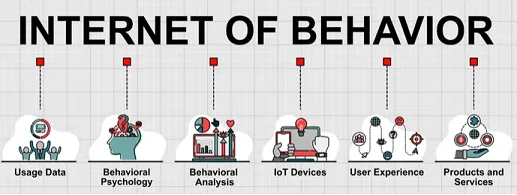
The Internet of Things (IoT) is defined as a source connecting an electric device to the Internet, and IoB (Internet of Behaviour) is the extension of IoT that reveals significant information about our behaviour. It is the interconnection of devices that provides vast data and valuable insights into user experience, search experience optimization, behaviour, interests, and preferences. According to Gartner, IoB combines technologies focused on tracking location and facial recognition of the people, connecting the data, and mapping them to behavioural events.
The Internet of Behaviour combines existing technologies that focus on the individuals directly. From facial recognition to location tracking, it connects the resulting data to associated behavioural events like cash purchases or device usage. Understanding the data collected from users’ online activity from a behavioural psychology perspective is what exactly IoB does! How to understand the data and how to apply that understanding to create and market new products from a human psychology perspective, all come under IoB.
IoB in simple words refers to the process by which user-controlled data is analysed through a behavioural psychology perspective and the data thus collected is used to understand how to market the end products and services offered by companies. To conduct IoB is technically not that complex as it is from a psychological perspective. This requires statistical studies to be conducted - mapping everyday habits and behaviours without fully disclosing consumer privacy for ethical and legal reasons.
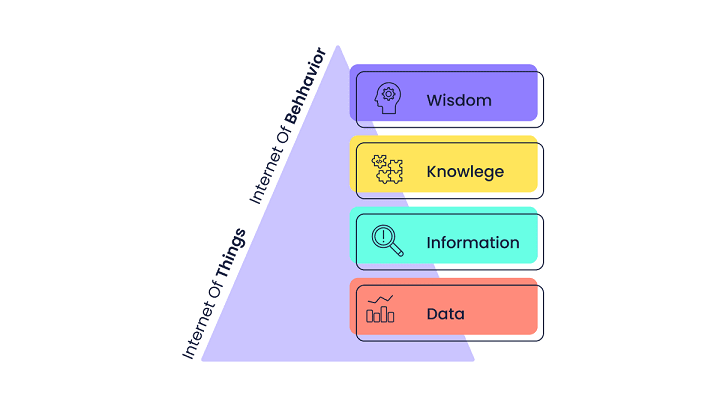
More recently, the IoB has gained attention, thanks to Gartner naming it among the world’s biggest strategic technology trends for 2021. “The Internet of Behaviour captures the ‘digital dust’ of people’s lives from a variety of sources, and that information can be used by public or private entities to influence behaviour,” according to the research firm. Gartner also predicted that 40 percent of people globally (more than three billion people) will have their behaviour tracked through the IoB by 2023 and that by the end of 2025, more than half of the world’s population will be subject to at least one IoB programme, whether it be commercial or governmental.
Whether it’s our social-media usage, geolocation data via our smartphones, credit-card purchases or even food preferences, data can originate from a multitude of sources. And as more of it can be gleaned from our daily activities, the IoB will capture more information about our behavioural patterns and choices. And by understanding this data, one can gain a significantly more granular understanding of people’s behaviour than was previously possible, which can enable interested parties to utilise it for a variety of use cases. “Internet of Behaviour (IoB) will be used to link a person digitally to their actions,” Gartner predicted. “For example, linking your image as documented by facial recognition with an activity such as purchasing a train ticket can be tracked digitally.”
The value of the Internet of Behaviour
Marketing and psychology from the beginnings of advertising go side by side. In this way, behavioural analysis and psychology have allowed new insights into the data collected by the Internet of Things.
The IoB can become a powerful new marketing and sales tool for businesses and organizations around the world. Using this tool, you will gain a deep understanding of your customers, which is necessary for every business.
To be sure, analytics, A/B testing, SWOT analysis, and many other techniques have helped the company for years build its product and marketing strategies to create and promote products that users will want to buy. Internet of Behaviour is intended to generate a considerable boost in the development of the sales industry.
The Advantages of IoB
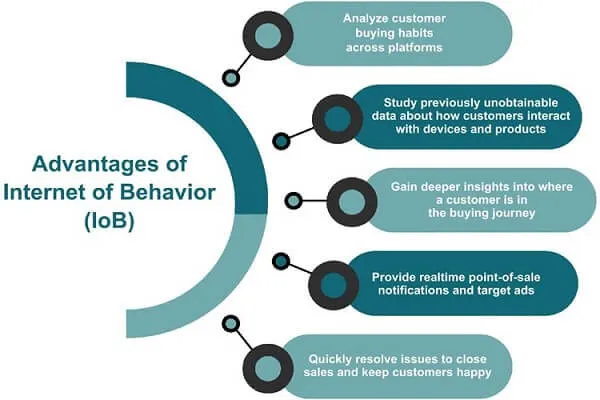
Key Risk Factors Associated with the Internet of Behaviour (IoB)
There is, however, a dark side of IoT and the integration of the behaviour data can allow cybercriminals access to sensitive data that reveals consumer behaviour patterns. Cybercriminals can collect and sell to other criminals hacked property access codes, delivery routes, even bank access codes, the potential is endless. However, more likely, they can take phishing to a new level by better impersonating individuals for the sake of fraud or other nefarious purposes - Which has been demonstrated by the biggest ever cybersecurity attack called the 'Solarwinds hack,' at a Global level targeting the US Government, its agencies, and many other private companies.
It is not difficult for companies to link your smartphone with your laptop, your in-home voice assistant, your house or car cameras, and maybe your cell phone records (texts and phone calls). Also, it's not just the devices themselves. Behind the scenes, many companies share (sell) data across company lines or with other subsidiaries. Google, Facebook, and Amazon continue to acquire software that potentially brings a single app user into their entire online ecosystem—frequently without our permission which presents significant security and legal risks. There is little legal protection in place for these concerns. The rapidly expanding network of IoT devices means that new cybersecurity protocols are in development and that businesses need to be ever more vigilant and proactive.
Applications of IoB in 2021
There are lots of applications of IoB you can explore in 2021 and apply in your context. Most businesses are utilizing online advertising as an effective way to reach more customers in the present age.
However, the Internet of Behaviour is making them able to identify and target to target specific individuals or groups that can benefit from their services and products. For example, both Facebook and Google are using the behavioural data of their users to display advertisements to the people accordingly. This is helping businesses in getting connected with their potential audience as well as track their behaviours towards their ads via click-through rate.
Similarly, YouTube is also utilizing behavioural analytics to improve the experience of its viewers. By tracking behavioural data, it is recommending users’ videos and shows which they are more interested in.
Even more, the latest technologies such as Siri, Google Home, and Alexa also study and interpret the data and behaviour of the user to work more efficiently.
Conclusion
Undoubtedly, A/B testing, SWOT analysis and many other techniques have helped companies for years to build their product and marketing strategies to create and promote that user would want to buy. The IoB will take this trend to the next level, and is set to generate considerable momentum in the development of the sales industry. According to Gartner, the technology may still be in its early days, but by the end of 2025, more than 50% of the world’s population will be exposed to at least one IoB programme, either from the government or a private company. It will be the ecosystem that defines human behaviour in an increasingly digital world.
For this reason, it will be essential to strike a balance between personalised offerings and intrusiveness to avoid adverse consumer reactions. Any company that chooses to adopt an IoB approach to its strategies must ensure that it has robust cyber security in place to protect all that sensitive data.
IoT-harvested data leveraged with IoB technology can be used to sell, but it’s not all targeted advertising. Organisations will be able to test, for example, the efficiency of their campaigns, both commercial and non-profit. Also, healthcare providers can measure patient activation and engagement efforts. In conclusion, its catalogue of applications is already extensive, but it will continue to expand as it becomes established in society.
Read more blogs here
